How to organise a small closet with lots of clothes: 14 expert tips and tricks
Wondering how to organise a small closet with lots of clothes? Follow these top tips to maximise precious wardrobe space...
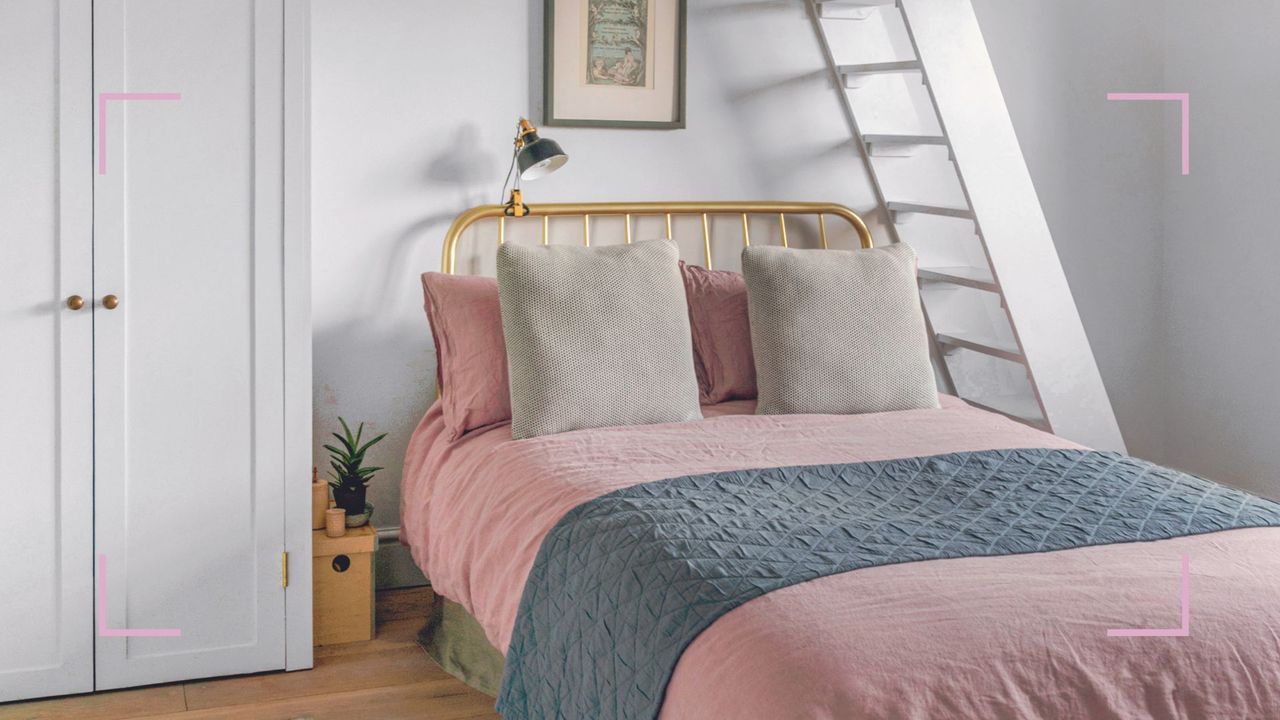

Don't let your small closet limit your love of fashion, simply look for smart ways to maximise storage space to ensure everything has a place and your wardrobe capacity is not compromised.
If you're wondering exactly how to organise a small closet with lots of clothes look no further because we've spoken to organisation experts and decluttering professionals to gain insider tricks to make the most of your space.
Using expert wardrobe organising techniques you can double your closet space and declutter your home in the process.
Even if you've mastered how to build a capsule wardrobe and have minimal amounts of clothing, these expert tips will keep your closet streamlined and functional for everyday use.
How to organise a small closet with lots of clothes: 14 expert tips
Start by making sure every inch of your limited closet isn't being restricted by unnecessary small bedroom storage mistakes.
"If you have a small wardrobe the first thing you need to do is think cleverly about the rest of your bedroom storage available," advises Vicky Silverthorn, Professional Organiser and founder of You Need A Vicky.
"Do I need a bed with built-in storage? Could I have a chest of drawers beside my bed instead of bedside tables? Is there any space for an ottoman? Because you can remove all your out-of-season clothes from your wardrobe altogether, freeing up valuable space."
Sign up for the woman&home newsletter
Sign up to our free daily email for the latest royal and entertainment news, interesting opinion, expert advice on styling and beauty trends, and no-nonsense guides to the health and wellness questions you want answered.
Once you've moved everything out of your closet that can be housed elsewhere, follow these tips from the experts at APDO, the association of professional declutterers and organisers, to make your space work as hard as possible.

Vicky has been a professional organiser for over 10 years, helping people from all walks of life, declutter and organise their homes. As an expert in the industry, she believes that your well-being starts at home; if your home is in shape, other elements of your life will follow. She's a member of APDO UK and a published author of an Amazon bestselling book: 'Start with Your Sock Drawer: The Simple Guide to Living a Less Cluttered Life.'
1. Start with a clothes audit

When organising a small space decluttering is always the first step. That way, everything you have left to organise is worthy of space.
"When organising my own and clients’ wardrobes and dressers, I start by removing all garments and by placing them on the bed," explains Elizabeth Wickes, found of The Lifestyle Organiser and member of APDO, the association of professional declutterers and organisers. "I do this in stages, as it can be overwhelming having a mountain of clothes in the middle of the room."
"Then, as you start selecting each garment, you will place it, in one of six sorting piles; keep; maybe; seasonal swap; donate; repair, and sell. The most common piece of advice to having an organised wardrobe is to let go of the items you never wear," advises Elizabeth.
If you have a surplus of clothing to sell but don't know where to start, head to our guide on how to sell clothes online.

Elizabeth is an APDO Accredited Professional Home & Lifestyle Organiser based in Suffolk, working across Cambridgeshire, Essex & Norfolk. She has been professionally organising lives for 13 years and running my dedicated professional home organising business for over 3 years – providing a bespoke and discreet in-home decluttering & organising service, as everyone’s personal spaces and lifestyle requirements are unique.
2. Store clothes by categories
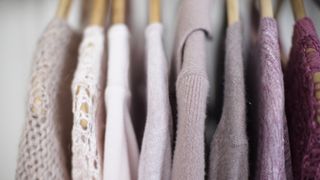
Next, restore some order to your clothes collection within your small closet to make it easier to find exactly what you need when getting dressed – in turn, making your morning routine far less stressful.
"Start by hanging your clothing by garment type first: Tops, blouses/shirts, sweaters, skirts, dresses, trousers, jackets, and then finally coats," advises Elizabeth.
"Then sort each type of clothing by the length of sleeve: Start with sleeveless (vests go first), short sleeve, and end with your long-sleeved items. Then within each category, segment by colour, starting with the lightest first. With mixed prints, you can either mix them in by their dominant colour or you can have them categorised separately at the end of each clothing type."
3. Save space with a vertical file fold

Try to incorporate drawers into your small closet storage system because folding items takes up far less space than hanging. If your wardrobe has deep shelves items can be folded and stored in baskets which then act like drawers.
"I'd recommend mastering the file fold," says Elizabeth, a practice that sees items stored vertically rather than stacked, to prove more efficient for finding specific items.
"Not only does this folding trick help bring calm and order to your drawers, but it also just makes life much easier to view and find your favourite T-shirt." There are many tutorial videos online to master the fold but essentially the fold is how you see neatly folded garments on display in clothing stores.
Elizabeth goes on to add, "I'd recommend storing your clothing items, like your underwear, nightwear, gym, and T-shirts in your dresser. By using the vertical fold technique, you can save on space and creasing. Plus, you can see everything clearly and you can remove items easily."
"Once you have folded your clothes using the vertical fold method, then you can divide your clothes, within each drawer using either drawer dividers and or storage pockets. These are great for corralling your underwear, knickers, and socks."
4. Adjust shelf spacing to maximize storage

Like when organising kitchen cabinets there is often valuable storage space wasted because of bad spacing when it comes to shelves.
"Shelves that have a greater distance apart means you're often piling things high, which is never an efficient use of space," says Vicky. "Consider reconfiguring your shelves, adding in extra shelves to make more storage space."
Could you fit an extra shelf in between your existing shelves to provide a more efficient and practical storage solution? As opposed to creating piles of clothes that have the potential to topple over daily when trying to retrieve items.
5. Utilise the backs of doors
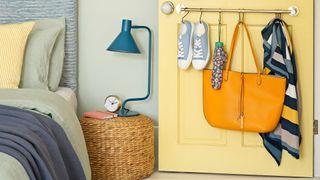
When space is at a premium, every surface available becomes a valuable storage solution and none more so than the back of the closet door.
"If you have a built-in closet in your bedroom, use the back of doors to hang dressing gowns, handbags, scarves, hats, etc," advises Elizabeth. "By installing sturdy screwed-in or over-the-door hooks (of course depending on the thickness of your doors), this will maximise your storage space and keep your clothes and accessories off the floors."
"Command hooks are ideal for keeping jewellery, accessories, belts and scarves close-to-hand and visible and can be easily attached to the back of a wardrobe door," suggests Kate Galbally, APDO member and founder of Better Organised.
6. Clear the floor

Keeping a clear floor will help to maintain a sense of order in a busy wardrobe bursting with clothes.
"Clear out the dumping ground at the bottom of the wardrobe. If you’re able to keep this area clear the rest of the wardrobe will immediately feel like it’s got more space," explains Suzanne Spencer, Master KonMari Consultant, APDO member, and Founder of A Life More Organised.
"These areas can get very full very quickly with all sorts of things – including clothes that have fallen off hangers. If you need to store things at the bottom then bags or shoes work well but keep them well organised so you can easily see what you have."
If you are using floor space for shoes then explore the best shoe organisation ideas to prevent them from clogging up the space, because that will make the already small space feel more limited. "Shoes are a massive space eater," warns Elizabeth, "basic flat shelves store shoes up high," to prevent them even being on the floor in the first place.
7. Rethink your hangers
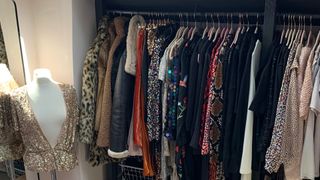
"Upgrade your hangers," says Suzanne. "Clear out empty hangers as they take up space – if you need to keep some use a box to store them tidily at the bottom of the wardrobe out of sight.
Having a matching set of hangers helps clothes to hang straight and save space (and stops the hangers from becoming tangled), switching to space-saving velvet hangers allows you to make the most of the space in your wardrobe."
"Skinny velvet hangers take up significantly less space than plastic or wooden hangers and are more visually appealing than wire ones," explains Kate. Adding matching mini hooks means you can store 2 or 3 items together in the most space-saving way possible! "
But it's imperative to research hangers to ensure they fit your clothes, warns Vicky, " because not all clothes are suitable for all hangers." Streamlining is one thing, but stretching the shoulders of your best garments is another.
8. Make better use of vertical space
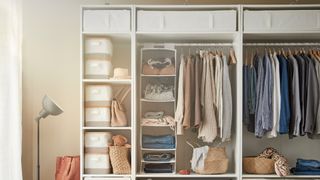
"If you have a tall but slim wardrobe, with lots of free and unused space at the top, add shelving to store items you don’t need as often," advises Siân Pelleschi, APDO Conference Director and founder of Sorted!.
Use boxes to keep items contained and looking neat. "Make the most of any shelves at the top of the wardrobe. It’s easy for things to disappear to the back of shelves and be forgotten about," warns Suzanne.
"I like to use baskets the full depth of the wardrobe (like these IKEA STUK baskets) as this makes it easy to use all the space and gives you easy access as you can just pull the basket down."
If you don't currently have shelving in place explore the possibility of putting a shelf in high for storing baskets of out-of-season clothing that you don't need to have access to daily, because otherwise, this is dead space going to waste.
9. Adjust your rail heights
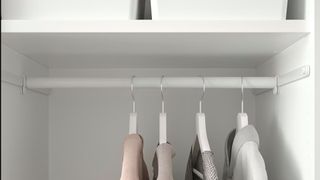
"You need to make the most of all of the space within the wardrobe. Look at your hanging space vs shelf space," suggests Elizabeth. "If you need more shelf space look to get a wardrobe hanging organiser. If you need more hanging space see if you can remove some of the shelves and add an extra rail."
"Look out for potential headspace," advises Vicky. "Say you had a hanging rail but there are 10 inches below, look to have your rails moved higher to make better use of the small space. That 10 inches could be a framework to put in alternative additional storage from baskets to shelving.
We recommend the IKEA HJÄLPA Adjustable clothes rails that give you the freedom to move and adjust your hanging layout with ease, allowing you to reconfigure the internal closet space to suit your needs.
10. Utilise the space on top of the closet
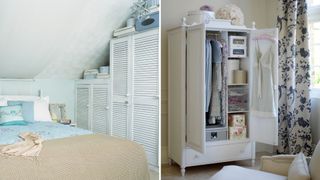
Look to make the most of the space on top of the closet to store baskets and boxes to prevent them from taking up space inside.
"If there is room on top of the wardrobe then use this dead space for seasonal clothes and shoes not being worn," advises Marie Bateson, APDO’s volunteer director and founder of Cut the Clutter.
"Aesthetically pleasing matching boxes with lids look good and of course must be lidded to stop things getting dusty." Lidded storage will make it far easier to get rid of dust than open baskets that may be left untouched for long periods.
11. Seek alternative storage under the bed
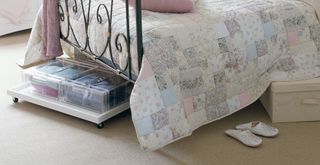
Think outside of the closet to maximise storage potential because for a small closet to function well it can't afford to be overwhelmed by too many clothes. A great place to store out-of-season or lesser-worn clothes is under the bed because the ample space is perfect for low-level storage bags or boxes that can be hidden from view.
"Under-the-bed storage is an easy storage solution, whether it's built-in draws or just space underneath this is a great way to use what could be wasted space," says Vickie Farrell, APDO member and founder of Declutteright. "Just remember it can get dusty under there so ensure you have good storage boxes with lids.
Rebecca Roberts, APDO member and founder of Curate My Space suggests: "If your bed is too low to get adequate storage underneath, use furniture riser blocks."
12. Use dividers to sort drawers

Once you've mastered 'the fold' it'll be beneficial to seek drawer dividers to ensure all items are streamlined and kept neat. You can buy smart drawer dividing solutions from any retailers that cater to storage, and they are often a cheap tool to offer maximum order to drawers and internal surfaces.
These multipurpose organisation accessories can provide and maintain order in internal closet drawers to make for more efficient storage. You simply place one inside a drawer and it creates little pockets in which your neatly folded items can be securely stored.
13. Hang extra vertical storage
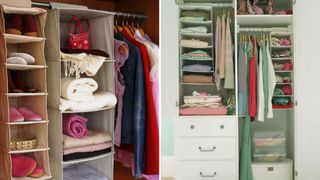
Hang extra vertical storage to cater to folded items so that not every item of clothing in the central part of your closet has to be hung.
This method of vertical storage utilises space more efficiently if you need more shelves but don't want to have them running the full width of the closet.
"You need to make the most of all of the space within the wardrobe," says Siân. "Look at your hanging space vs shelf space. If you need more shelf space look to get a wardrobe hanging organiser."
14. Pack a suitcase
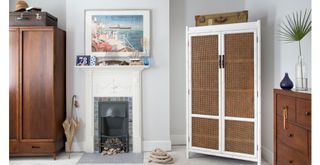
Consider packing your suitcase – not for a holiday but to store your out-of-season wardrobe most practically.
An otherwise empty suitcase will still take up the same amount of space whether stored empty or packed, so make it count by using the capacity to neatly pack the case full with all the items you won't need access to for the next few months.
Either store it at the back of the wardrobe or move it to a spare room or attic room to free up space. If your suitcase is an attractive design you could even store it on top of the closet to add a decorative touch.
How can I maximise my small closet?
The key to maximising a small closet is to employ the best methods of firstly decluttering your clothes. Our contributor Millie Hurst tried the 90/90 decluttering method to organise her small closet and found it transformative.
The principle of the 90/90 decluttering rule is to ask yourself have you used an item in the last 90 days? If you haven’t, will you use it in the next 90? If not, then it’s okay to let go and remove it from your wardrobe to free up valuable space. "This simple professional decluttering method made it much easier to work out what should stay and what should go," said Millie.
Once you are left with only items you truly wear you need to find savvy storage solutions to make your small closet feel bigger. Think floor storage units to maximise shoe storage and elevate it off the floor, multifunctional clothes hangers to double hanging capacity and
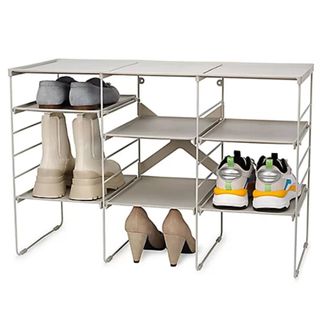
RRP: £75 | Keeping the floor clear is a great way to make a small closet feel more organised. An adjustable shoe rack is ideal to footwear neatly out of the way. This unit holds up to 12 pairs.
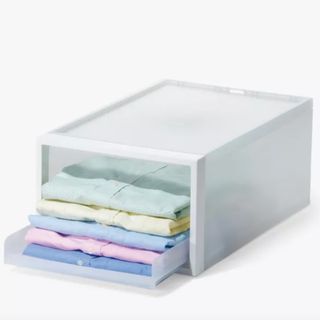
RRP: £25 | A storage cube such as this will keep your folded garments organised while still being easily accessible. The sturdy frame prevents weight bending the drawer, so it can be stacked if you need more than one.
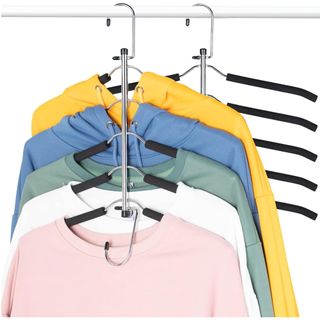
RRP: £20 | When space is scarce you need to be savvy with your storage solutions – and they don't come much smarter than these 5-in-1 clothes hangers at Amazon.
Keeping a closet organised is easy when you get into good daily habits to keep your home clean and tidy and it helps to make every day start the right way – cool, calm and collected.

Tamara is a highly experienced homes and interiors journalist with a career spanning over 22 years. Now the Lifestyle Editor of womanandhome.com, she previously spent 18 years working with the style teams at Country Homes & Interiors and Ideal Home. With these award-winning interior teams, she gained a wealth of knowledge and honed her skills and passion for styling and writing about every aspect of lifestyle and interiors.
A true homes and interiors expert, Tamara has been an ambassador for leading interior brands on multiple occasions, including appearing on Matalan’s The Show and presenting at top interior trend forecasting events such as the Autumn Fair and Spring Fair.
-
 5 non-injectable beauty treatments to try for skin rejuvenation, tightening and more
5 non-injectable beauty treatments to try for skin rejuvenation, tightening and moreCovet healthy, glowing skin without needles? Turn your attention to these high-tech facials…
By Emma Stoddart Published
-
 Lorraine Kelly exudes class in cocoa-toned dress with slip-on shoes as she blends elegance and comfort
Lorraine Kelly exudes class in cocoa-toned dress with slip-on shoes as she blends elegance and comfortLorraine Kelly has found a high street gem with her brown & Other Stories dress and her slip-on shoes complete the chic ensemble
By Emma Shacklock Published